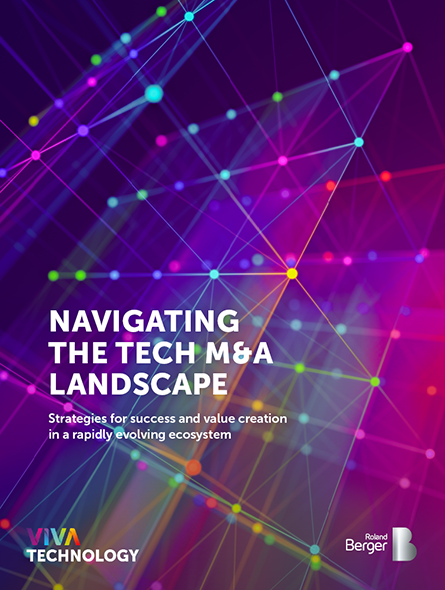Venture capital firms are at the forefront of the green transformation by investing in innovative solutions, generating returns for limited partners, and actively transforming companies. This study examines the momentum of climate concerns in the tech ecosystem, as well as the integration of climate-related targets by VC firms and the challenges facing the ecosystem in the future.


Navigating the Tech M&A Landscape
Strategies for Success and Value Creation in a Rapidly Evolving Ecosystem
As technology continues to shape ecosystems across all industries and global circumstances remain uncertain, businesses are reassessing growth strategies. Harnessing the power of cutting-edge technologies like cloud computing, artificial intelligence, and data analytics, these forward-thinking companies are rewriting the rules.
Acknowledging this trend, Roland Berger and Viva Technology initiated a comprehensive study to investigate the primary Tech M&A drivers and uncover patterns in integration practices. Leveraging insights from global executives representing both corporate giants and agile scale-ups who have played significant roles in major M&A transactions in recent years, this study aims to synthesize key findings.
A new era: Key drivers for Tech M&A
A strategic topic for all industries
The current economic landscape presents a favorable scenario for acquisitions, with declining valuations and expanding market opportunities. Across all sectors, technological disruptions have led to increased Tech M&A activity. Europe, in particular, has witnessed a significant surge in Tech M&A transactions, their numbers nearly doubling (+87%) from 2020 to 2021. However, challenges such as cybersecurity risks, talent acquisition, complex regulatory frameworks, and evolving consumer expectations must be acknowledged.

The rise of generative AI offers transformative potential, making Tech M&A an avenue to access expertise, technologies, and datasets for innovation. Proactively developing and executing a well-defined Tech M&A strategy is crucial for organizations in tech-driven industries. Indeed, in Europe, the InfoTech sector leads the way, accounting for almost half (47%) of total transactions.

Strategic objectives behind Tech M&A
Tech M&A transactions are fueled by a wide array of strategic objectives. Companies leverage these acquisitions to effectively propel their growth trajectory, expand their business operations, and foster innovation through a series of targeted smaller acquisitions. Moreover, the pursuit of international expansion remains a significant motivator, as these transactions grant immediate access to local infrastructure, supply chains, and customer bases, thereby expediting time to market and securing a competitive advantage in new markets. Simultaneously, Tech M&As enable organizations to seamlessly integrate disruptive innovations, streamline costs, and attain economies of scale, bolstering overall efficiency, profitability, and competitiveness. Additionally, acqui-hires allow companies to access rare skill sets in sectors where expertise is scarce, contributing to their talent pool. Finally, acquiring established companies or technologies enables businesses to bypass lengthy product development cycles, swiftly gain access to critical technologies, and penetrate new markets, ultimately positioning themselves ahead of the competition.
Critical factors for successful integration
A smooth and successful integration relies on multiple factors that are critical and must be carefully considered.
Aligning the organizations
Successful M&A integration hinges on aligning organizations and establishing effective governance structures. Continuous improvement, streamlining strategies, and implementing best practices are essential for successful integration processes. There are several organizational patterns, such as top-down and bottom-up approaches, which can drive the integration process. Additionally, involving key leaders from the acquired company fosters alignment and facilitates effective communication. Aligning management, addressing operational considerations, and establishing an Integration Management Office (IMO) all contribute to a seamless integration.
Communicating with the right tone and timing
Clear and effective communication is crucial for the success of Tech M&A initiatives. It serves as a foundation for keeping stakeholders well informed, alleviating concerns, building trust, and ensuring seamless business continuity. Tailoring the communication strategy and taking into account the perspectives of employees, customers, suppliers, and investors are vital aspects. In cross-border transactions, it becomes even more essential to overcome language barriers and bridge time zone differences. By adopting a clear and concise communication approach, stability, trust, and commitment can be fostered throughout the M&A process.
Addressing cultural differences
Cultural differences play a major role in shaping integration patterns and must be given due attention for successful M&A integration. Conducting an early cultural assessment, gaining insights into how culture influences decision-making, and leveraging these differences can facilitate a faster pace of change. It is essential to develop custom integration strategies that align with the values and practices of the organizations involved to ensure a smooth and effective integration process.
Prioritizing customer and people metrics over financial KPIs
In Tech M&A, success measurement extends beyond financial metrics to encompass strategic alignment, innovation potential, and market share expansion, which are given top priority. It is crucial to strike a balance between providing support and guidance to the acquired company while allowing them to maintain some independence and control. Startups typically have expectations of financial resources, defined processes, access to customer portfolios, and strong operational capabilities from acquirers. Addressing concerns related to brand identity and culture also requires empowering startup employees and preserving their unique culture. In the end, assessing factors such as cultural alignment, talent retention, and customer satisfaction is essential to accurately measure the success of the integration.
The dynamic landscape of Tech M&A presents both challenges and opportunities for companies across industries. In order to adapt to technological disruptions and secure competitive positions, companies need to understand the diverse strategic intents behind Tech M&A. This allows them to accelerate growth, expand internationally, integrate innovations, and tap into rare skill sets. By focusing on customer-centric and people-oriented metrics, they can attain a comprehensive understanding of integrations, and strengthen their positions.
Register now to download the full PDF including key insights, new developments as well as future challenges and new opportunities for players in the M&A industry














